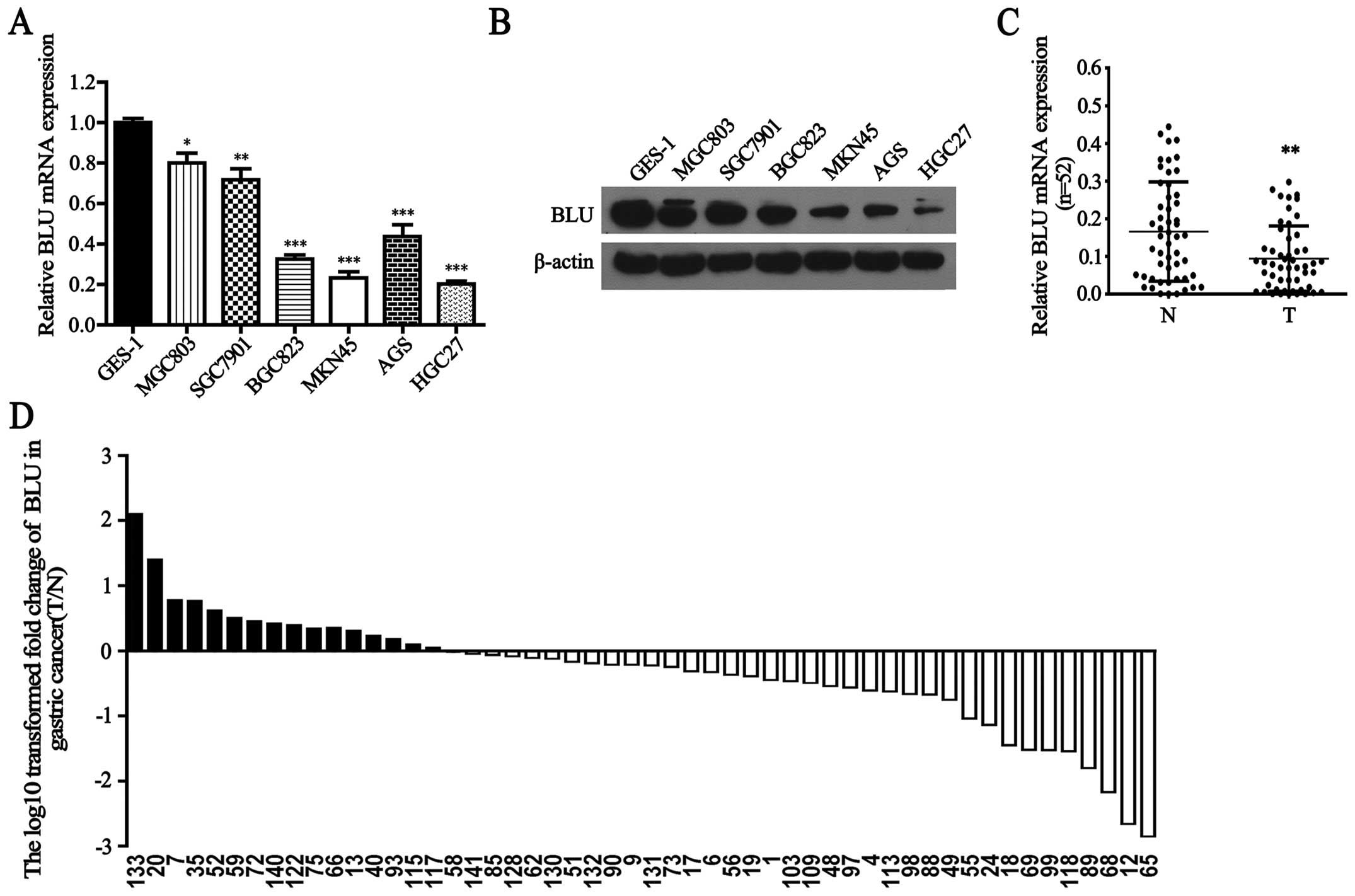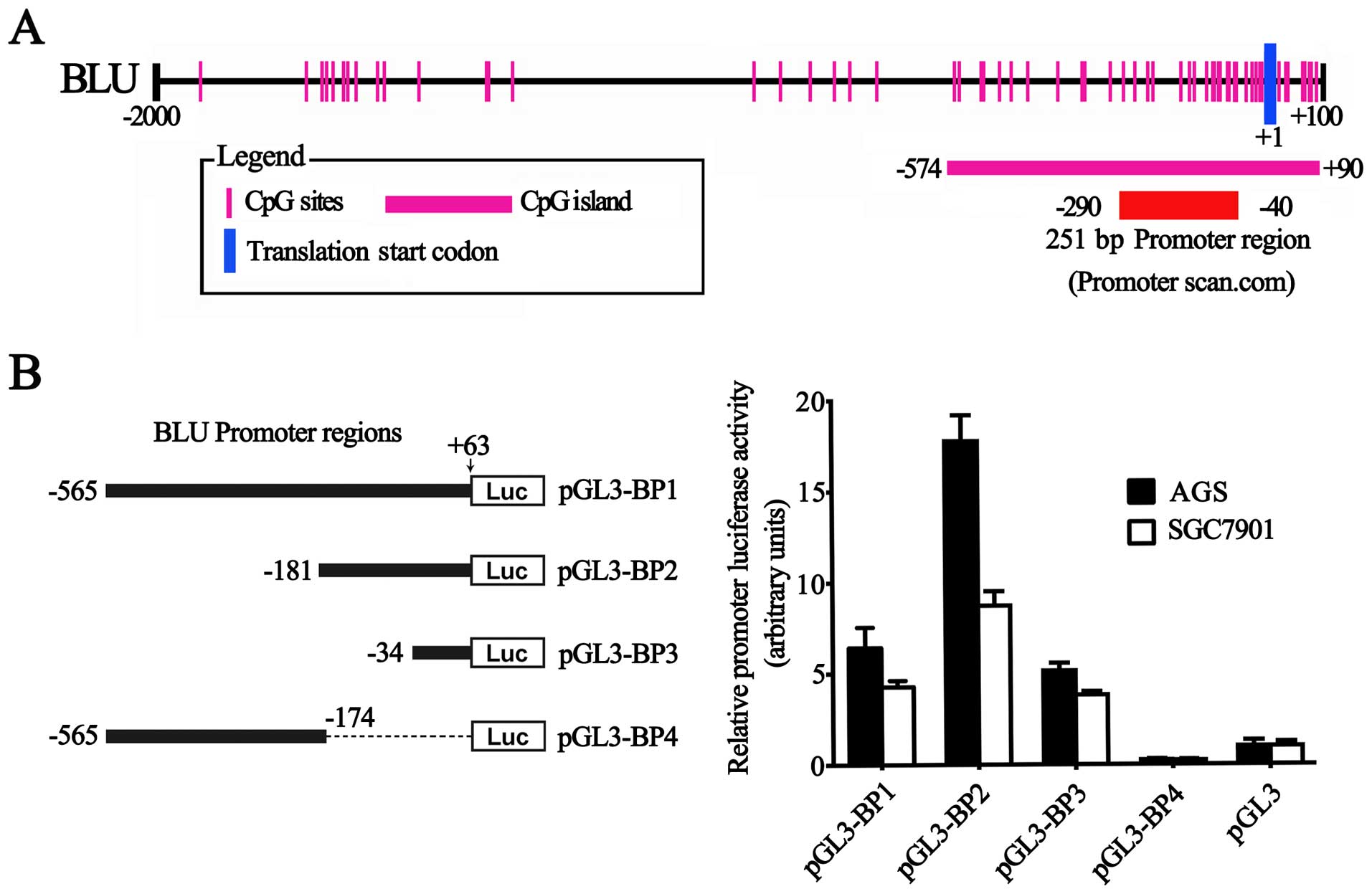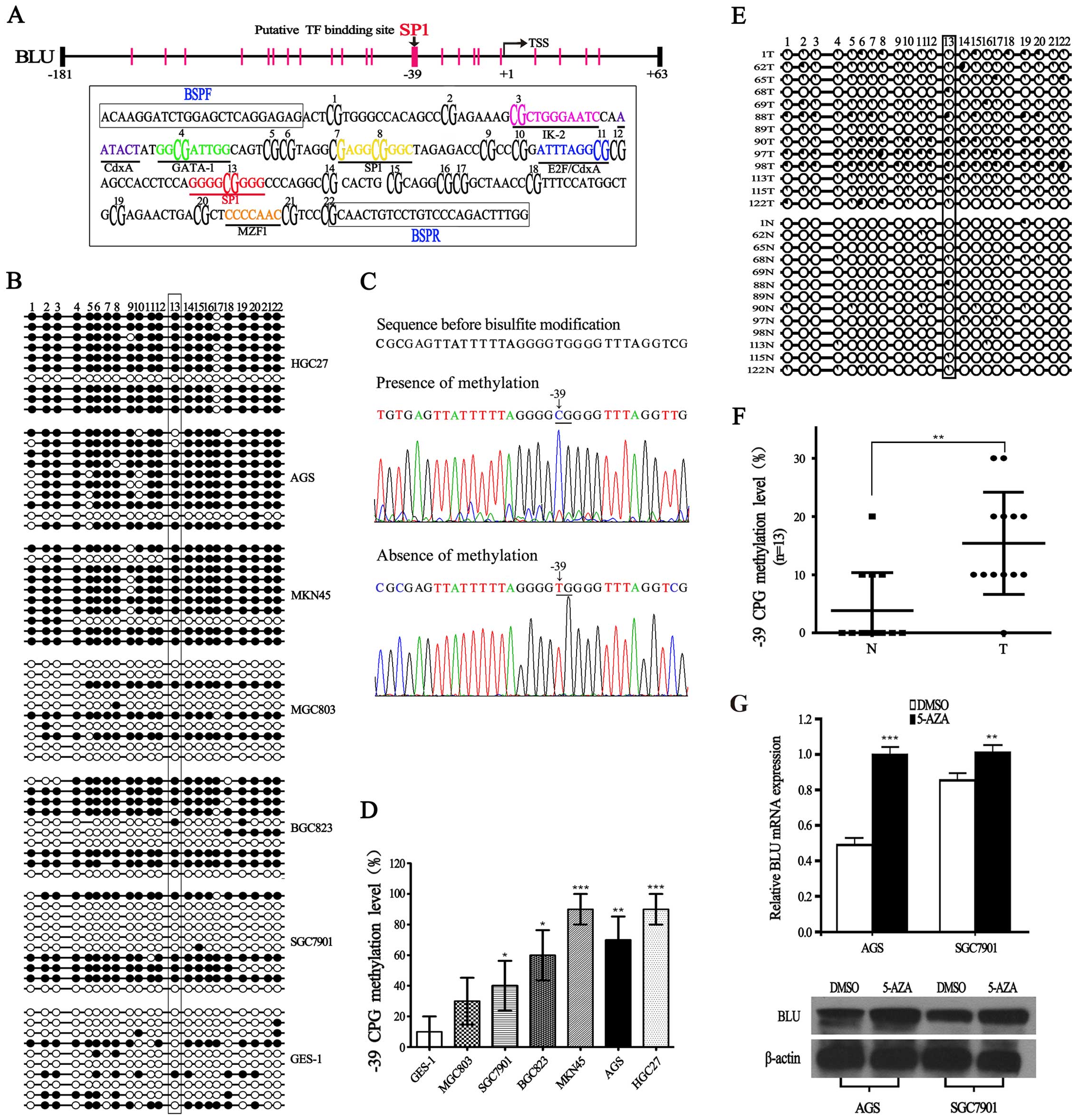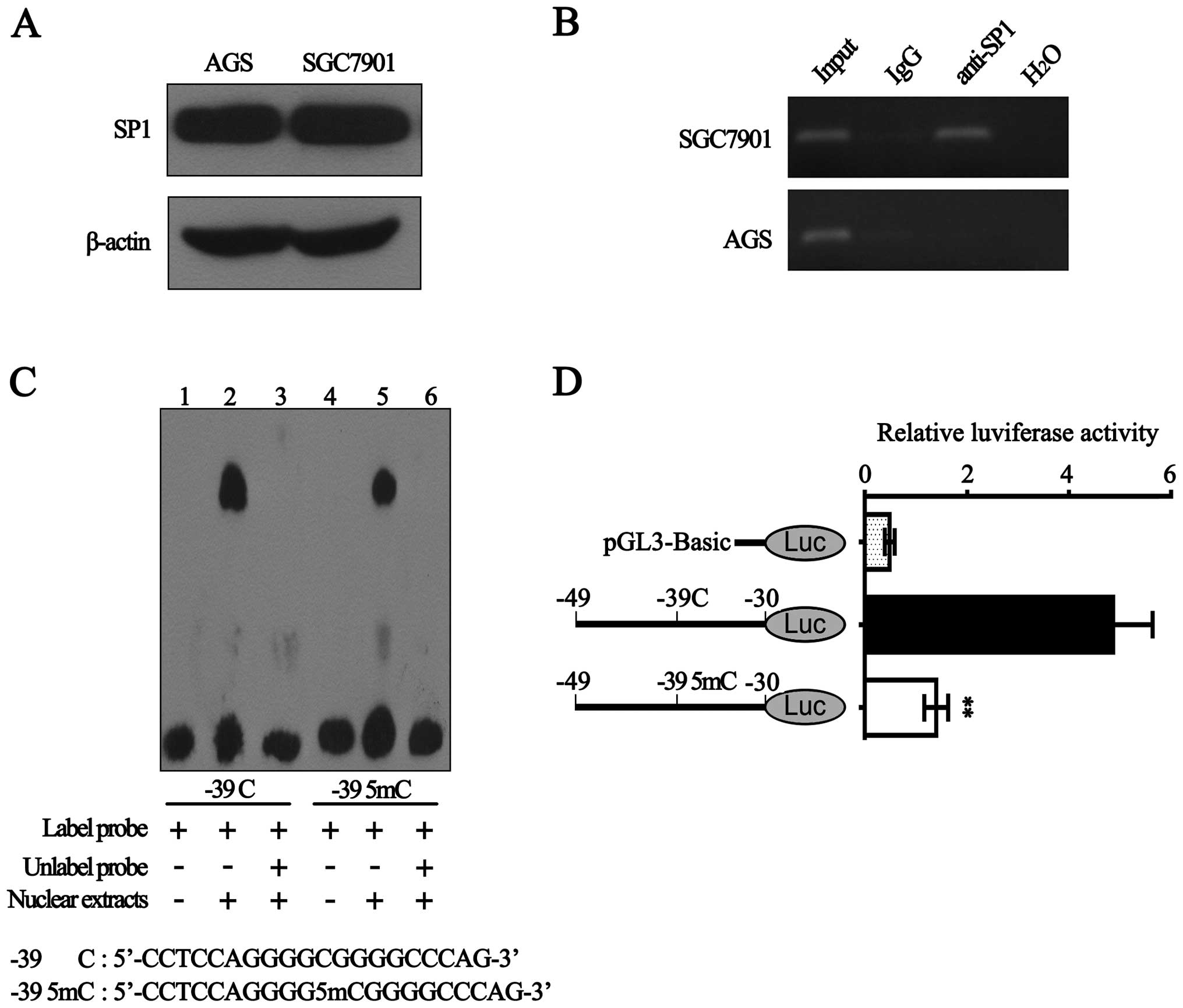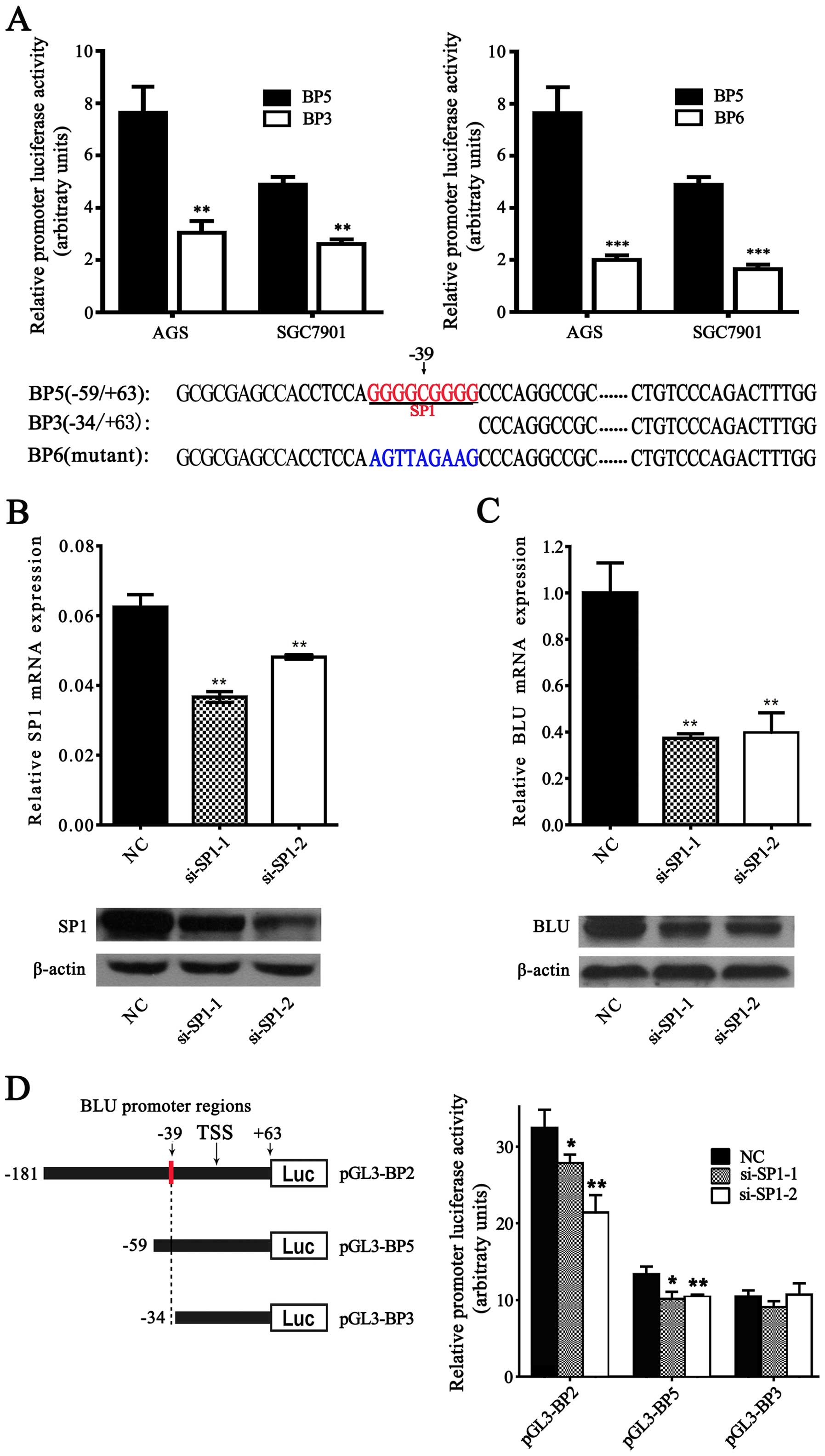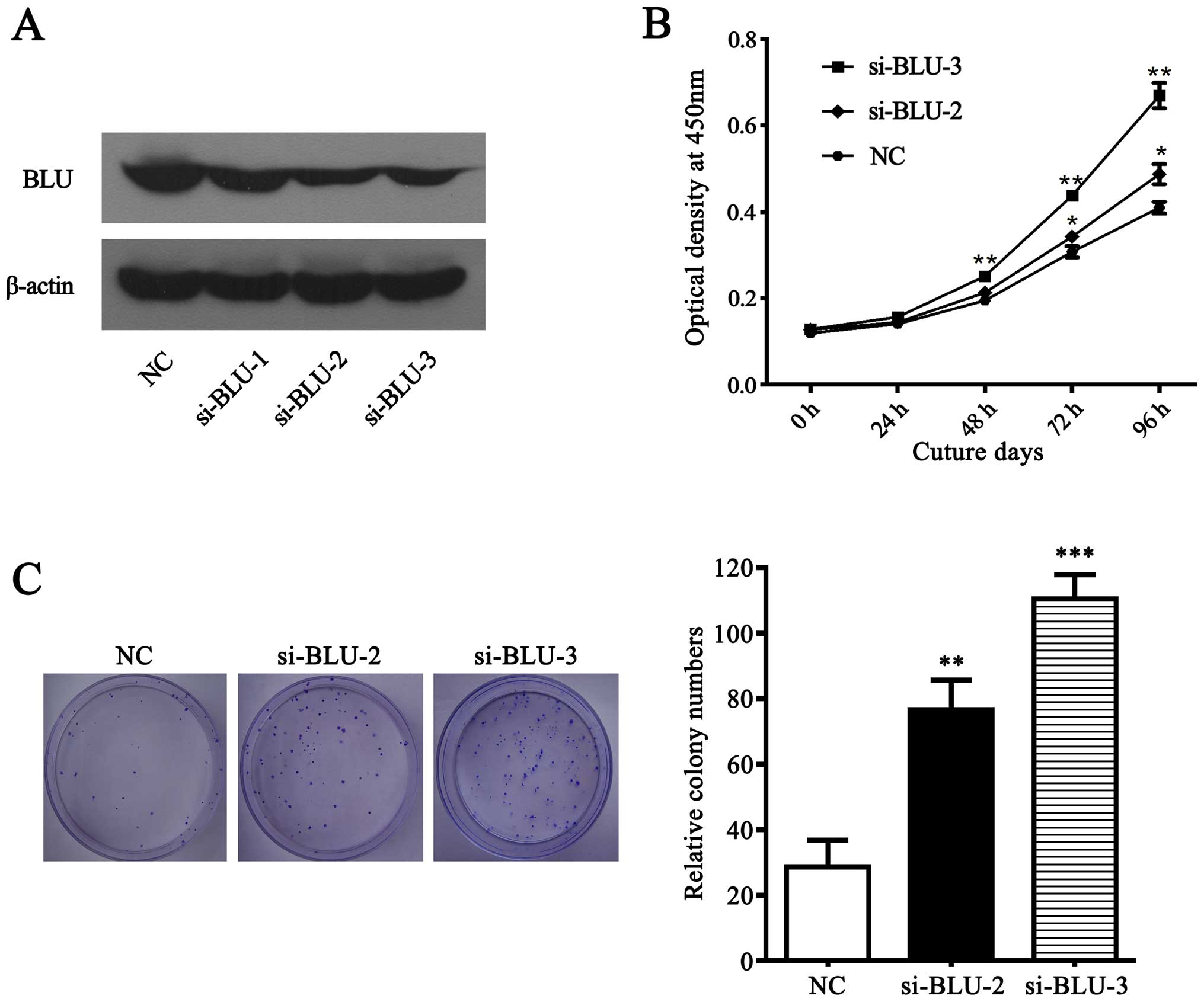Inactivation of BLU is associated with methylation of Sp1-binding site of BLU promoter in gastric cancer
- Authors:
- Published online on: June 4, 2015 https://doi.org/10.3892/ijo.2015.3032
- Pages: 621-631
Abstract
Introduction
Approximately one million people were newly diagnosed as gastric cancer patients and 738,000 new deaths were related to this malignancy in 2012 worldwide. The highest morbidity and mortality of gastric cancer are reported in countries of Eastern Asia, especially China (1,2). Several high-risk etiologic factors, such as Helicobacter pylori infection, heavy salt consumption, smoking, and genetic alterations, have been proved to be associated with gastric cancer (3,4). In addition, epigenetic alterations, including DNA methylation, histone modification and microRNAs, are also involved in the initiation and progression of gastric cancer (5,6). Of note, promoter methylation has been considered as a common mechanism leading to the silence of tumor suppressor genes (TSGs) (7,8). Since the precise mechanisms underlying the gastric tumor are still unclear, the identification of TSGs inactivated by promoter hypermethylation may provide new insights into the initiation and development of gastric cancer.
BLU was first identified by Lerman and Minna in 2000, it is also named ZMYND10 (zinc finger, MYND-type containing 10) and located at human chromosome 3p21.3 (9). The BLU protein is ~50 kDa and contains a MYND zinc finger DNA binding domain at its C-terminus, which was similar to the domains found in transcription repressors such as ETO (MTG8) and BS69 (10–12). As reported in previous studies, BLU served as a tumor suppressor in human nasopharyngeal carcinoma and ovarian carcinomas via inhibiting proliferation, inducing apoptosis and anti-angiogenic (13–16). Moreover, BLU was found frequently inactivated by the promoter hypermethylation in various human cancers, which could be restored by demethylating agent 5-Aza treatment (17–21). However, the expression and biological functions of BLU in gastric cancer remain unknown.
DNA methylation was reported to epigenetically inhibit gene expression via blocking the binding of transcription factor (TF) such as Sp1 to hypermethylated CpG dinucleotides within TF-binding sites (22–25). In this study, our in silico prediction has shown that two putative Sp1-binding sites are harbored in TATA-less BLU promoter, which are relative to the transcription start site of BLU. Moreover, given the fact that Sp1 is a transcription activator and Sp1-binding sites are crucial for the basal transcription of genes with TATA-less promoter (26,27), it is possible that the methylation of CpG within Sp1-binding site in the BLU promoter can lead to inactivation of BLU. Furthermore, Sp1 has been recognized to play an essential role in tumorigenesis (28). Therefore, the identification of Sp1-regulated expression of BLU may provide new clues to pathogenesis of malignancies, including gastric cancer.
Our present study supported the idea that BLU was inactivated due to its promoter hypermethylation in human cancers. However, the mechanisms by which hypermethylation results in the silencing of BLU gene have not yet been reported. In the present study, we suggest that BLU promoter hypermethylation is able to prevent Sp1 from binding to BLU promoter in gastric cancer, and this mechanism may provide an explanation for silencing of the BLU gene.
Materials and methods
Cell culture
Six human gastric cancer cell lines (SGC7901, HGC27, BGC823, MKN45, MGC803 and AGS) and human gastric epithelial cell line GES-1 were obtained from the Cell Bank of the Chinese Academy of Sciences (Shanghai, China). SGC7901, MKN45, MGC803, and AGS were maintained in the RPMI-1640 medium (Hyclone, South Logan, UT, USA) containing 10% fetal bovine serum (FBS, Invitrogen, Carisbad, CA, USA). HGC27, BGC823 and GES-1 were cultured in the DMEM medium (Invitrogen) supplemented with 10% FBS. All cells were incubated at 37°C in a humid atmosphere of 5% CO2.
Tissues samples
Fifty-two paired gastric cancer tissues and adjacent non-cancerous gastric tissues were obtained after informed consents from patients at the First Affiliated Hospital of Soochow University. Tissue samples were collected, immediately snap-frozen in liquid nitrogen and stored in −80°C until analysis. None of the patients had received chemotherapy or radiotherapy prior to surgery. This research was approved by the Academic Advisory Board of Soochow University.
Demethylating agent 5-Aza treatment
5-Aza was purchased from Sigma-Aldrich Corp. (St. Louis, MO, USA) and dissolved in sterile double distilled water. Cells were plated at a density of 1×105 cells per well in the 6-well plates and incubated overnight. On days 1, 3 and 5, the medium was changed to serum-free RPMI-1640 containing 10 μM 5-Aza. On days 2 and 4, the medium was changed to 5-Aza free RPMI-1640 with 3% FBS. The cells were harvested for further study on day 5.
Quantitative real-time reverse transcription PCR (qRT-PCR)
Total RNA was extracted from cells using RNAiso Plus (Takara Biotech Co., Ltd., Dalian, China) according to the manufacturer’s protocol. Total mRNA (1 μg) was reverse-transcribed by the M-MLV reverse transcriptase (Invitrogen). Subsequently, aliquots of cDNA were subjected to PCR by using FastStart Universal SYBR Green Master (ROX) (Roche, Basel, Switzerland) on a LightCycler® 96 Real-Time PCR System (Roche). Primers for mRNA detection of BLU, Sp1 and β-actin (internal control) were as follows: for BLU, 5′-AAC CAGCAGCATGAGAACCT-3′ (forward) and 5′-AGTTTGCG GTGGCAATAGTC-3′ (reverse); for Sp1, 5′-CCTCCAGACC ATTAACCTCAG-3′ (forward) and 5′-TCCACCTGCTGTGT CATCAT-3′ (reverse); for β-actin, 5′-CACAGAGCCTCGCCTT TGCC-3′ (forward) and 5′-CACATGCCGGAGCCGTTGTC-3′ (reverse). The amplification conditions were as follows: 95°C for 10 min, followed by 40 cycles of 95°C for 10 sec and 60°C for 30 sec. Relative fold-change in gene expression was determined using the ΔΔCt method normalized to β-actin.
Bisulfite sequencing
Genomic DNA was extracted from cells using DNeasy Blood and Tissue kit (Qiagen, Hilden, Germany) and then bisulfited using EpiTect Bisulfite kit (Qiagen) according to the manufacturer’s instructions. The sodium bisulfite-modified genomic DNA was subjected to PCR amplification with primers which specially designed to analysis the methylation status of 22 CpG sites within a 244-bp region of the BLU promoter (−181 to +63). The primers were: 5′-ATAAG GATTTGGAGTTTAGGAGAG-3′ (forward) and 5′-CCAAAA TCTAAAACAAAACAATTAC-3′ (reverse). PCR products were purified by Gel Extraction kit (Omega, USA) and cloned into pMD19-T vector (Takara) for DNA sequencing. At least ten clones from each sample were randomly selected and then sequenced.
Western blot assay
Cells were lysed in RIPA buffer (Cell Signaling Technology) with the protease inhibitor (Sigma-Aldrich Corp.). Equal amounts of total protein were separated on SDS-PAGE and transferred to the nitrocellulose membranes (Millipore, Billerica, MA, USA). The membranes were blocked with 3% BSA-TBST buffer for 1 h at room temperature and then incubated with appropriate primary antibodies overnight at 4°C. Next, the membranes were washed with TBST buffer three times and incubated with the corresponding HRP-conjugated secondary antibodies for 2 h at room temperature. The specific protein band detection was performed using a commercial ECL kit (Pierce, Rockford, IL, USA). β-actin was used as internal control. The following antibodies were used for western blot analysis: rabbit anti-BLU polyclonal antibody (ab96700, 1:2,000, Abcam, Cambridge, UK); rabbit anti-Sp1 polyclonal antibody (#9389S, 1:1,000, Cell Signaling Technology, Danvers, MA, USA); rabbit anti-β-actin polyclonal antibody (sc-130656,1:1,000, Santa Cruz Biotechnology, Santa Cruz, CA, USA).
Chromatin immunoprecipitation (ChIP) assay
The ChIP assay was performed using EZ-ChIP™ Chromatin Immunoprecipitation kit (Millipore). Immunoprecipitation was performed by the addition of anti-Sp1 antibody, and rabbit IgG antibody was used as a negative control. A fragment of the BLU promoter (−80/+108), which contains putative Sp1-binding sites (−43/−35) was amplified by semi-quantitative PCR with primers as follows: 5′-TAGAGACCCGCCCGGAT TTA-3′ (forward) and 5′-GGGTGGGGATGCTGTCACAT-3′ (reverse). PCR products were analyzed by electrophoresis on a 2% agarose gel and stained with ethidium bromide.
Electrophoresis mobility shift assay (EMSA)
Nuclear extracts were isolated from cells using Nuclear Protein Extraction kit (Solarbio, Beijing, China). The EMSA assay was performed by LightShift Chmiluminescent EMSA kit (Pierce) following the manufacturer’s instructions. The 5′ biotin-labeled and double-stranded oligo probes containing putative Sp1 binding sites (−43/−35) were chemically synthesized by Invitrogen. The sequences of probes were as follows: −39C (unmethylated) 5′-CCTCCAGGGGCGGGGCCCAGTTG-3′ and −39 5mC (methylated) 5′-CCTCCAGGGG5mCGGGGCCCAGTTG-3′; unlabeled probes 5′-CCTCCAGGGGCGGGGCCCAGTTG-3′ were synthesized as cold competitor. Electrophoresis mobility gel shift assay was performed as described previously (29).
Plasmid construction, transfection and luciferase report assays
The pGL3-basic dual luciferase vector (Promega, Madison, WI, USA) was used to produce a series of constructs containing various truncated regions of BLU promoter. Two fragments of interest BLU promoter regions containing the unmethylated and methylated −39 CpG (5′-CCTCCAGGGG CGGGGCCCAG-3′ and 5′-CCTCCAGGGG5mCGGGGCC CAG-3′, respectively) were directly chemically synthesized and massively inserted into the luciferase pGL3-basic vector, and then purified by using Universal DNA purification kit (Tiangen, Beijing, China). To assess promoter activity, cells were transiently co-transfected with BLU promoter constructs and RenillaphRL-TK plasmid (Promega) using Lipofectamine 2000 (Invitrogen). Twenty-four hours later, cells were harvested, and luciferase activities were measured by the Dual-Luciferase Reporter assay kit (Promega) on a TD20/20 Luminometer (Turner Designs, Sunnyvale, CA, USA). Results are expressed as relative luciferase activities, which are normalized to Renilla luciferase activities.
RNA interference experiments
Small interfering RNA (siRNA) sequences (Table I), which target Sp1 and BLU, were chemically synthesized (GenePharma, Shanghai, China). Scrambled siRNA was used as a negative control (NC). Cells were transiently transfected with 100 pmol of siRNA sequences using Lipofectamine 2000 (Invitrogen). After 72-h transfection, the cells were harvested for further experiments.
Cell proliferation
Cell viability was measured by a cell Counting Kit-8 (CCK-8) (Yeasen, Shanghai, China). After being transfected with or without siRNA as described above, 100 μl SGC7901 and AGS cell suspensions (2×104 cells/ml) were plated into each well of 96-well plates. Then 10 μl CCK-8 solution was added to each well and incubated for 2 h. The absorbance was measured at 450 nm on a microplate reader (MRX, Dynex Technologies, West Sussex, UK).
Colony formation assay
Two thousand cells were plated in 60-mm culture dishes and incubated at 37°C for 2 weeks; visible cell colonies were fixed with methanol for 15 min, then stained with Giemsa for 1 h, washed with water and colonies containing ≥50 cells were counted under a microscope.
Statistical analysis
Statistical analysis was performed using the SPSS 19.0 software (SPSS Inc, Chicago, IL, USA). All quantitative data were obtained from at least three independent experiments and represented as means ± SD or SEM. Difference between the means of two groups was compared using Student’s t-tests. Comparisons between clinicopathologic characteristics and expression levels of mRNA in gastric cancer samples were performed with non-parametric tests (Mann-Whitney U test for 2 groups, Kruskall-Wallis test for ≥3 groups). P<0.05 was considered to be statistically significant.
Results
BLU expression is reduced in gastric cancer cells and tissues
To verify whether inactivation of BLU contributes to gastric carcinogenesis, we first detected BLU mRNA expression in human gastric cancer cells and GES-1 cells. As shown in Fig. 1A, BLU mRNA was significantly lower in MGC803, SGC7901, BGC823, MKN45, AGS and HGC27 cells than that in GES-1 cells (P<0.05, P<0.01, P<0.001, P<0.001, P<0.001 and P<0.001, respectively). Consistently, BLU protein levels were also downregulated in gastric cancer cells (Fig. 1B). In addition, BLU mRNA expression was notably reduced in 69% (36/52) gastric cancer tissues when compared with their paired adjacent non-cancerous tissues (P<0.01, Fig. 1C and D). No significant difference in BLU mRNA level was observed between gastric cancer tissues when classified by various clinicopathologic characteristics (Table II).
Table IICorrelation between clinicopathological features and expression levels of BLU mRNA in gastric cancer. |
Identification and characterization of a functional CpG-rich BLU promoter
To define the BLU promoter, a 2,100-bp sequence, including BLU proximal promoter (−2,000–+1)) and 5′-UTR (+1–+100) regions (RefSeq: NC_000003.12 and NM_015896), was available for analysis. A 251-bp region spanning positions −290 to −40 relative to the transcription start site was predicted to be the putative promoter of the BLU gene using the Promoter Scan program (Fig. 2A). This region contains a GC box, but lacks a TATA box. A potential CpG island spanning positions −574 to +90 was identified by Methyl Primer Express® software v1.0 (Applied Biosystems) (Fig. 2A).
To evaluate the effects of this sequence on transcription, we generated the luciferase report constructs containing various lengths of the BLU proximal promoter and 5′-UTR region. As presented in Fig. 2B, the fragment (−181 to +63) had the highest activity, while the second largest fragment (−565 to −174) had less activity than the largest and smallest fragments (−565 to +63; −34 to +63, respectively) (Fig. 2B), suggesting that an active cis-element was putatively at position −181 to +63 and a repressive element resides was located between positions −565 to −174 in the BLU promoter. Taken together, the results indicated that the indentified BLU promoter is indeed functional.
In silico prediction of functional CpG sites in BLU promoter
Using Methyl Primer Express software (Applied Biosystems), we identified that the 244-bp BLU promoter region (−181 to +63) contains 22 CpG sites (Fig. 3A). Using the transcription factor search program TFSEARCH (http://mbs.cbrc.jp/research/db/TFSEARCH.html), two putative transcription factor Sp1-binding sites were predicted at position −43/−35 and −89/−81 relative to the transcription start site, each of them contains one CpG site (−39 CpG and −85 CpG, respectively). Binding sites for several other potential transcription factor, such as IK-2 (one site), CdxA (two sites), GATA-1 (one site), E2F (one site), MZF1 (one site) were also noted (Fig. 3A). Since the BLU promoter lacks TATA box and the binding sites of transcription factor Sp1 was reported to be crucial for the basal transcription of TATA-less promoters, we then investigated the putative functions of −39 CpG and −85 CpG in the regulation of BLU expression.
The BLU promoter is hypermethylated in gastric cancer
We performed bisulfite sequencing (BSP) analysis to investigate whether promoter CpG methylation is associated with the loss of BLU expression. As shown in Fig. 3B, the hypermethylation of BLU was detected in AGS, MKN45, HGC27, BGC823 and SGC7901 cells, while BLU was hypomethylated in GES-1. Importantly, we observed that the methylation level of −39 CpG is significantly higher in the five gastric cancer cell lines with relatively low BLU mRNA expression (Fig. 3B–D). In addition, we also found a negative correlation between −39 CpG methylation level and BLU expression in tumor samples (Fig. 3E and F). Furthermore, we treated AGS and SGC7901 cells with demethylating agent 5-Aza, and found that BLU mRNA and protein levels were restored in AGS and SGC7901 cells (Fig. 3G). These results implied that hypermethylation of BLU promoter may play an important role in transcription silencing of the BLU gene in human gastric cancer.
Sp1 specifically binds to the BLU promoter and hypermethylation of −39 CpG decreases its binding ability
It is well known that Sp1 is one of the first identified eukaryotic transcription factors (30). Hypermethylation of CpG dinucleotides within Sp1-binding sites could block Sp1 binding to promoter (22,23). Being in silico predicted to be within Sp1-binding sites in BLU promoter, the −39 CpG was hypermethylated in 5 gastric cancer cell lines with low BLU mRNA expression. Thus, we suggest the possibility that hypermethylated −39 CpG may affect the recruitment of Sp1 to BLU promoter. To test this, we performed the following experiments.
First, western blot analysis showed that Sp1 protein expression in SGC7901 cells was nearly equaled with that in AGS cells (Fig. 4A). Subsequently, we performed ChIP assay in AGS and SGC7901 cells. As shown in Fig. 4B, with the DNA samples immunoprecipitated by anti-Sp1 as templates, a 188 bp BLU promoter sequence (−80 to +108 bp) containing −39 CpG was amplified in SGC7901 cells, but not in AGS cells. Considering that the methylation level of −39 CpG in AGS cells was higher than SGC7901 cells (Fig. 3B and C), the results suggested that hypermethylation of −39 CpG significantly inhibited the interaction between Sp1 and BLU promoter.
Next, EMSA assay showed that although both the probe containing unmethylated −39 CpG and the probe containing methylated −39 CpG could form DNA-protein complexes with nuclear extracts of SGC7901 cells, binding ability of unmethylated probe is stronger than the methylated probe (Fig. 4C). This indicated that methylation of −39 CpG within Sp1 binding-sites may reduce the complex formation.
Furthermore, we constructed the luciferase reporter vectors containing the corresponding unmethylated and methylated fragments (Sp1-binding sites) and then transiently transfected them into SGC7901 cells. As shown in Fig. 4D, methylated −39 CpG significantly diminished the luciferase activity by ~70%. Taken together, our results demonstrated that Sp1 could specifically bind with the BLU promoter and hypermethylation of −39 CpG significantly reduced the recruitment of Sp1 to BLU promoter.
Sp1 activates the BLU promoter
To explore whether Sp1 could regulate transcriptional activity of the BLU promoter, we performed the luciferase report assay in SGC7901 cells. As a result, the constructs containing the Sp1-binding site (BP5: −59/+63) showed significant higher activity than the constructs with deletion of Sp1-binding site (BP3: −34/+63) and the mutant constructs (BP6: −59/+63) (Fig. 5A). Furthermore, siRNA-mediated knockdown of endogenous Sp1 effectively decreased the mRNA and protein expression level of BLU (Fig. 5B and C). After co-transfection of the BLU promoter constructs (BP2: −181/+63 and BP5: −59/+63) containing the Sp1-binding sites with si-Sp1, knockdown of Sp1 decreased the luciferase activities of these constructs when compared with the negative control (NC) (Fig. 5D). By contrast, downregulation of Sp1 presented no significant effects on the luciferase activity of the construct (BP6: −34/+63) lacking the Sp1-binding sites. Our results demonstrated that the sequence of the BLU promoter (positions −43 to −35) is a functional Sp1-binding site and Sp1 could activate the BLU promoter.
Knockdown of BLU promotes the growth of gastric cancer cells
BLU was frequently downregulated in gastric cancer cells and primary tumors, suggesting that BLU is likely a tumor suppressor in gastric cancer. To investigate the affects of BLU on the growth of gastric cancer cells, we performed CCK-8 and colony formation assays in SGC7901 cells transfected with BLU siRNAs or negative control. As expected (Fig. 6A), BLU was significantly silenced in SGC7901 cells transfected with si-BLU-2 and si-BLU-3. Subsequently, CCK-8 and colony formation experiment showed that BLU knockdown promoted cell viability and clonogenicity (Fig. 6B and C), suggesting that BLU acts as a tumor suppressor via inhibiting cell growth in gastric carcinoma.
Discussion
Gastric carcinoma is the fifth most common cancer and second leading causes of cancer related deaths worldwide (1). During the past decades, despite many improvements in the early detection and treatment of gastric cancer, >50% of gastric cancers were diagnosed at advanced stages and the overall prognosis is unsatisfactory (31–34). Higher incidence rate of gastric carcinoma leads to even more actual problems in China (35). Therefore, to further elucidate the underlying mechanisms of gastric cancer has become an urgent requirement.
In the present study, we demonstrated that the BLU expression was commonly downregulated in gastric cancer. Moreover, silencing BLU with siRNA significantly promoted the cellular proliferation and clonogenicity, indicating that BLU served as a tumor suppressor in gastric cancer. Our results were supported by a panel of previous studies which detected the frequent loss of BLU in nasopharyngeal carcinoma, ovarian carcinoma, non-small cell lung carcinoma, glioma and esophageal cancer (18–21,36). Promoter hypermethylation has been recognized as common mechanism leading transcriptional inactivation of TSGs in many types of cancer (37,38). In the present study, we found that the expression of BLU in gastric cancer was notably repressed by promoter CpG hypermethylation, especially by hypermethylated −39 CpG site which is located within Sp1-binding transcription element. Moreover, the demethylating agent treatment significantly restored the expression of BLU in gastric cancer cells. These results provided evidence that loss of BLU in gastric cancer is caused at least partly by the promoter hypermethylation. Similar phenomenon was also reported in glioma, cervical neoplasia and other malignancies (12,17,20).
Subsequently, we tried to clarify the mechanisms underlying epigenetically silenced BLU expression in gastric cancer. First, we identified a functional BLU promoter which lacks a TATA-box and contains two GC boxes. As a transcription activator, Sp1 binds to GC box and regulates the basal transcription of TATA-less promoters (26,27,39). Using ChIP, EMSA and luciferase reporter assays, we identified that Sp1 could specifically bind to the BLU promoter (−43/−35) and regulate its transcriptional activity. Moreover, −39 CpG was located within the predicted Sp1-binding sites and frequently hypermethylated in gastric cancer. In fact, DNA methylation was considered to repress epigenetically gene expression via blocking the binding of transcription factor such as E2F and Sp1 to hypermethylated CpG dinucleotides within TF-binding sites (22–25). Consistently, our data showed that −39 CpG methylation significantly reduced transcription activity of BLU by ~70%. Combined with ChIP and EMSA assay, the results indicate that hypermethylation of −39 CpG may decrease BLU expression via interfering with the binding of Sp1.
As previously reported, the hypermethylation progress lacks alteration in the gene sequences and can be reversed. The demethylated agent 5-Aza was able to restore the function of the TSGs silenced by promoter hypermethylation (29,40). In the present study, we also observed that BLU expression was restored after treatment with 5-Aza in AGS and SGC7901 cells. In addition, we found that knockdown of BLU promoted gastric cell proliferation and clonogenicity. These results suggest that BLU may become a potential target for epigenetic therapy of gastric cancer.
In conclusion, we identified a novel functional BLU promoter and proved that BLU promoter activity was regulated by Sp1. Furthermore, we found that hypermethylated −39 CpG in BLU proximal promoter directly reduced its binding with Sp1, which may be one of the mechanisms accounting for the inactivation of BLU in gastric cancer.
Acknowledgements
The authors would like to thank the patients with gastric cancer for their participation and cooperation. This study was supported in part by the grants from Natural Science Foundation of Jiangsu Province Colleges (14KJB320014), Suzhou Key Laboratory for Molecular Cancer Genetics (SZS201209) and A Project funded by the Priority Academic Program Development of Jiangsu Higher Education Institutions (PAPD).
References
|
Ferlay J, Soerjomataram I, Dikshit R, Eser S, Mathers C, Rebelo M, Parkin DM, Forman D and Bray F: Cancer incidence and mortality worldwide: Sources, methods and major patterns in GLOBOCAN 2012. Int J Cancer. 136:E359–E386. 2015. View Article : Google Scholar | |
|
Jemal A, Bray F, Center MM, Ferlay J, Ward E and Forman D: Global cancer statistics. CA Cancer J Clin. 61:69–90. 2011. View Article : Google Scholar : PubMed/NCBI | |
|
Uemura N, Okamoto S, Yamamoto S, Matsumura N, Yamaguchi S, Yamakido M, Taniyama K, Sasaki N and Schlemper RJ: Helicobacter pylori infection and the development of gastric cancer. N Engl J Med. 345:784–789. 2001. View Article : Google Scholar : PubMed/NCBI | |
|
Nobili S, Bruno L, Landini I, Napoli C, Bechi P, Tonelli F, Rubio CA, Mini E and Nesi G: Genomic and genetic alterations influence the progression of gastric cancer. World J Gastroenterol. 17:290–299. 2011. View Article : Google Scholar : PubMed/NCBI | |
|
Qu Y, Dang S and Hou P: Gene methylation in gastric cancer. Clin Chim Acta. 424:53–65. 2013. View Article : Google Scholar : PubMed/NCBI | |
|
Oue N, Mitani Y, Motoshita J, Matsumura S, Yoshida K, Kuniyasu H, Nakayama H and Yasui W: Accumulation of DNA methylation is associated with tumor stage in gastric cancer. Cancer. 106:1250–1259. 2006. View Article : Google Scholar : PubMed/NCBI | |
|
Jones PA and Baylin SB: The fundamental role of epigenetic events in cancer. Nat Rev Genet. 3:415–428. 2002.PubMed/NCBI | |
|
Baylin SB and Herman JG: DNA hypermethylation in tumorigenesis: Epigenetics joins genetics. Trends Genet. 16:168–174. 2000. View Article : Google Scholar : PubMed/NCBI | |
|
Lerman MI and Minna JD: The 630-kb lung cancer homozygous deletion region on human chromosome 3p21.3: Identification and evaluation of the resident candidate tumor suppressor genes. The International Lung Cancer Chromosome 3p213 Tumor Suppressor Gene Consortium. Cancer Res. 60:6116–6133. 2000.PubMed/NCBI | |
|
Masselink H and Bernards R: The adenovirus E1A binding protein BS69 is a corepressor of transcription through recruitment of N-CoR. Oncogene. 19:1538–1546. 2000. View Article : Google Scholar : PubMed/NCBI | |
|
Wolford JK and Prochazka M: Structure and expression of the human MTG8/ETO gene. Gene. 212:103–109. 1998. View Article : Google Scholar : PubMed/NCBI | |
|
Agathanggelou A, Dallol A, Zöchbauer-Müller S, Morrissey C, Honorio S, Hesson L, Martinsson T, Fong KM, Kuo MJ, Yuen PW, et al: Epigenetic inactivation of the candidate 3p21.3 suppressor gene BLU in human cancers. Oncogene. 22:1580–1588. 2003. View Article : Google Scholar : PubMed/NCBI | |
|
Cheng Y, Ho RL, Chan KC, Kan R, Tung E, Lung HL, Yau WL, Cheung AK, Ko JM, Zhang ZF, et al: Anti-angiogenic pathway associations of the 3p213 mapped BLU gene in nasopharyngeal carcinoma. Oncogene. Oct 27;2014 (Epub ahead of print). View Article : Google Scholar : 2014. | |
|
Zhang X, Liu H, Li B, Huang P, Shao J and He Z: Tumor suppressor BLU inhibits proliferation of nasopharyngeal carcinoma cells by regulation of cell cycle, c-Jun N-terminal kinase and the cyclin D1 promoter. BMC Cancer. 12:2672012. View Article : Google Scholar : PubMed/NCBI | |
|
Park ST, Byun HJ, Kim BR, Dong SM, Park SH, Jang PR and Rho SB: Tumor suppressor BLU promotes paclitaxel antitumor activity by inducing apoptosis through the downregulation of Bcl-2 expression in tumorigenesis. Biochem Biophys Res Commun. 435:153–159. 2013. View Article : Google Scholar : PubMed/NCBI | |
|
Yoo HJ, Kim BR, Byun HJ, Park SY and Rho SB: BLU enhances the effects of anti-angiogenic activity in combination with gemcitabine-based chemotherapeutic agents. Int J Biochem Cell Biol. 45:1236–1245. 2013. View Article : Google Scholar : PubMed/NCBI | |
|
Lai HC, Lin YW, Chang CC, Wang HC, Chu TW, Yu MH and Chu TY: Hypermethylation of two consecutive tumor suppressor genes, BLU and RASSF1A, located at 3p21.3 in cervical neoplasias. Gynecol Oncol. 104:629–635. 2007. View Article : Google Scholar | |
|
Ito M, Ito G, Kondo M, Uchiyama M, Fukui T, Mori S, Yoshioka H, Ueda Y, Shimokata K and Sekido Y: Frequent inactivation of RASSF1A, BLU, and SEMA3B on 3p21.3 by promoter hypermethylation and allele loss in non-small cell lung cancer. Cancer Lett. 225:131–139. 2005. View Article : Google Scholar : PubMed/NCBI | |
|
Yi Lo PH, Chung Leung AC, Xiong W, Law S, Duh FM, Lerman MI, Stanbridge EJ and Lung ML: Expression of candidate chromosome 3p21.3 tumor suppressor genes and downregulation of BLU in some esophageal squamous cell carcinomas. Cancer Lett. 234:184–192. 2006. View Article : Google Scholar | |
|
Hesson L, Bièche I, Krex D, Criniere E, Hoang-Xuan K, Maher ER and Latif F: Frequent epigenetic inactivation of RASSF1A and BLU genes located within the critical 3p21.3 region in gliomas. Oncogene. 23:2408–2419. 2004. View Article : Google Scholar : PubMed/NCBI | |
|
Qiu GH, Tan LK, Loh KS, Lim CY, Srivastava G, Tsai ST, Tsao SW and Tao Q: The candidate tumor suppressor gene BLU, located at the commonly deleted region 3p21.3, is an E2F-regulated, stress-responsive gene and inactivated by both epigenetic and genetic mechanisms in nasopharyngeal carcinoma. Oncogene. 23:4793–4806. 2004. View Article : Google Scholar : PubMed/NCBI | |
|
Zhang X, Yang R, Jia Y, Cai D, Zhou B, Qu X, Han H, Xu L, Wang L, Yao Y, et al: Hypermethylation of Sp1 binding site suppresses hypothalamic POMC in neonates and may contribute to metabolic disorders in adults: Impact of maternal dietary CLAs. Diabetes. 63:1475–1487. 2014. View Article : Google Scholar : PubMed/NCBI | |
|
Guo D, Wu B, Yan J, Li X, Sun H and Zhou D: A possible gene silencing mechanism: Hypermethylation of the Keap1 promoter abrogates binding of the transcription factor Sp1 in lung cancer cells. Biochem Biophys Res Commun. 428:80–85. 2012. View Article : Google Scholar : PubMed/NCBI | |
|
Ehrlich S, Weiss D, Burghardt R, Infante-Duarte C, Brockhaus S, Muschler MA, Bleich S, Lehmkuhl U and Frieling H: Promoter specific DNA methylation and gene expression of POMC in acutely underweight and recovered patients with anorexia nervosa. J Psychiatr Res. 44:827–833. 2010. View Article : Google Scholar : PubMed/NCBI | |
|
Campanero MR, Armstrong MI and Flemington EK: CpG methylation as a mechanism for the regulation of E2F activity. Proc Natl Acad Sci USA. 97:6481–6486. 2000. View Article : Google Scholar : PubMed/NCBI | |
|
Lania L, Majello B and De Luca P: Transcriptional regulation by the Sp family proteins. Int J Biochem Cell Biol. 29:1313–1323. 1997. View Article : Google Scholar | |
|
Emili A, Greenblatt J and Ingles CJ: Species-specific interaction of the glutamine-rich activation domains of Sp1 with the TATA box-binding protein. Mol Cell Biol. 14:1582–1593. 1994.PubMed/NCBI | |
|
Yuan H, Gong A and Young CY: Involvement of transcription factor Sp1 in quercetin-mediated inhibitory effect on the androgen receptor in human prostate cancer cells. Carcinogenesis. 26:793–801. 2005. View Article : Google Scholar : PubMed/NCBI | |
|
Qian Q, Shi X, Lei Z, Zhan L, Liu RY, Zhao J, Yang B, Liu Z and Zhang HT: Methylated +58CpG site decreases DCN mRNA expression and enhances TGF-β/Smad signaling in NSCLC cells with high metastatic potential. Int J Oncol. 44:874–882. 2014.PubMed/NCBI | |
|
Dynan WS and Tjian R: The promoter-specific transcription factor Sp1 binds to upstream sequences in the SV40 early promoter. Cell. 35:79–87. 1983. View Article : Google Scholar : PubMed/NCBI | |
|
Hundahl SA, Phillips JL and Menck HR: The National Cancer Data Base Report on poor survival of U.S. gastric carcinoma patients treated with gastrectomy: Fifth Edition American Joint Committee on Cancer staging, proximal disease, and the ‘different disease’ hypothesis. Cancer. 88:921–932. 2000. View Article : Google Scholar : PubMed/NCBI | |
|
Dikken JL, van de Velde CJ, Coit DG, Shah MA, Verheij M and Cats A: Treatment of resectable gastric cancer. Therap Adv Gastroenterol. 5:49–69. 2012. View Article : Google Scholar : PubMed/NCBI | |
|
Mickevicius A, Ignatavicius P, Markelis R, Parseliunas A, Butkute D, Kiudelis M, Endzinas Z, Maleckas A and Dambrauskas Z: Trends and results in treatment of gastric cancer over last two decades at single East European centre: A cohort study. BMC Surg. 14:982014. View Article : Google Scholar : PubMed/NCBI | |
|
Forman D and Burley VJ: Gastric cancer: Global pattern of the disease and an overview of environmental risk factors. Best Pract Res Clin Gastroenterol. 20:633–649. 2006. View Article : Google Scholar : PubMed/NCBI | |
|
Rahman R, Asombang AW and Ibdah JA: Characteristics of gastric cancer in Asia. World J Gastroenterol. 20:4483–4490. 2014. View Article : Google Scholar : PubMed/NCBI | |
|
Chiang YC, Chang MC, Chen PJ, Wu MM, Hsieh CY, Cheng WF and Chen CA: Epigenetic silencing of BLU through interfering apoptosis results in chemoresistance and poor prognosis of ovarian serous carcinoma patients. Endocr Relat Cancer. 20:213–227. 2013. View Article : Google Scholar : PubMed/NCBI | |
|
Wanajo A, Sasaki A, Nagasaki H, Shimada S, Otsubo T, Owaki S, Shimizu Y, Eishi Y, Kojima K, Nakajima Y, et al: Methylation of the calcium channel-related gene, CACNA2D3, is frequent and a poor prognostic factor in gastric cancer. Gastroenterology. 135:580–590. 2008. View Article : Google Scholar : PubMed/NCBI | |
|
Jones PA and Laird PW: Cancer epigenetics comes of age. Nat Genet. 21:163–167. 1999. View Article : Google Scholar : PubMed/NCBI | |
|
Batistuzzo de Medeiros SR, Krey G, Hihi AK and Wahli W: Functional interactions between the estrogen receptor and the transcription activator Sp1 regulate the estrogen-dependent transcriptional activity of the vitellogenin A1 io promoter. J Biol Chem. 272:18250–18260. 1997. View Article : Google Scholar : PubMed/NCBI | |
|
Christman JK: 5-Azacytidine and 5-aza-2′-deoxycytidine as inhibitors of DNA methylation: Mechanistic studies and their implications for cancer therapy. Oncogene. 21:5483–5495. 2002. View Article : Google Scholar : PubMed/NCBI |



